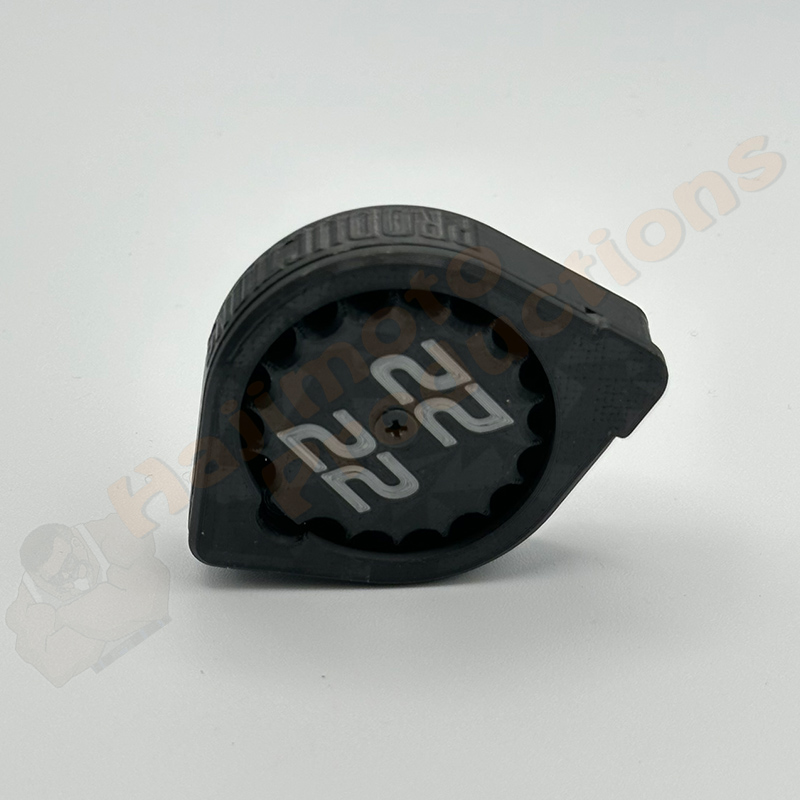A few years ago I published some articles in the airgun forums and community that I have referred folks to read but recently found our that some of the forums have changed there format or layout which broke the links I had to the articles. I have decided to writ it here on Hajimoto Productions blog so it is easier to find and refer to.
There has been a growing trend where paintball regulator and tank swapping techniques have made their way over to the HPA / PCP world and this should not be happening. Please let me explain, Co2 produces around 800 psi of pressure so a removable bottle with a ball or pin seal can be removed without much of an issue. That said, if you examine the internal and the regulator threads of a used paintball gun, you will witness substantial wear to the threads.
When you start hitting 1400PSI or higher there is an incredible amount of stress exerted on the regulator bonnet threads and the PCP threads. They begin to gall and wear excessively when being screwed in or out under pressure.


Anything over 1200 psi should have the ball seal or pin seal removed to prevent the bottle from being filled off the PCP and then screwed on which is why most of your higher operating pressure bottle guns (except FX which has a very well engineered close tolerance activation gap on the internal valve) cannot be filled off the PCP.
Case and point is the newly released Gauntlet 30 caliber which still uses a paintball style regulator but the output pressure or operating pressure is 2800psi. Paintball threads were never designed to deal with those pressures and be actively threaded on or off.
I know we have all seen videos or articles where the instructor shows how you loosen the bottle and shoot down the pressure remaining in the PCP you can easily remove the bottle. The initial loosening of the bottle causes the thread damage. If you do not believe me, look at the galling of the thread of some bottles that have been removed or installed under pressure, they will be thinner and razor-sharp as the metal is deformed during this process.
While the thought of carrying around another tank that can be swapped in if needed seems like a great idea, its not. Install and align your regulator and tank and leave them installed. Always refill the tank on the PCP and if you need to service anything, degas the PCP and then unscrew the regulator and tank.
Do yourself a solid, don't install or remove your bottles under pressure without understanding that you are reducing the service life of that part.
We have finally released our Haji-Notos builder which allows a shooter to select and build a capable compact shooter. The Umrex Notos is a great compact shooter in its own right but we feel that it can be so much more. That said, you know how we operate, so we turned up the awesome factor and created a very hard-hitting compact shooter that you will love.
Hello guys and gals we are excited to introduce a completely redesigned HP magazine that allows for easier loading and simpler operation.

The new HP Mag 2.0 will eventually replace the previous no-lid design in all calibers such as .177, .22, .25, and .30 in both the expanded and the mini versions. The new design utilizes strong neodymium magnets that allow full access to the magazine loading slot. This means no more fighting to drop pellets/slugs into a limited window or opening during loading.
The magnets force the lid to align in one direction. They are also so strong that they typically spin the lid so it aligns almost automatically!

Just like the original magazines, these HP 2.0 designs are platform-specific which means we spent many hours tweaking and adjusting fit and operation to each specific PCP. This means you will have a well-fitting close-tolerance part that is durable and looks great for thousands of shots.

The first few HP 2.0 designs to be released are the .22 Gauntlet Expanded, .22 Notos, .22 Origin Expanded, .22 Avenger Expanded, and .22 Benjamin Marauder.
Get yours HERE!
As you guys may remember, we stopped installing our Side Lever in the G30 but were not able to tell you why. Well, we can tell you why now!
Introducing the Umarex Gauntlet 30 SL! That's right the G30 now is available with Side Lever cocking. Once all the Stock Bolt Action G30's in the warehouses are gone, you will only be able to snag the G30SL.
We have both in stock and in all of the configurations you would expect including our G30 Builder which allows you to select the options you want to create your own package.
Just to be clear we do still offer our Sidelever option on all G1 .177/.22/.25 or G2 .22/25 Calibers. Just go to AIRGUN SERVICES or click HERE to be brought directly to the Service.
Christmas Deal!
Get your G2 or G30 outfitted with our PowerFlex Combo. This como allows you to adjust your operating pressure on the fly, without the need to degas or go internal to the PCP to adjust. The carbon fiber tank provides 370cc / 22.5ci of volume and shaves off 1/2 a pound in weight. As you can see, the tank length is far more appealing and balanced.
Being able to adjust your operating pressure means you can dial your Gauntlet in to get the most out of the ammo you are shooting. We even made a video showing how simple it is to install yourself.
From now until we can no longer secure any additional G1's, for Umarex USA, all of our G1 Packages will come with the 22 cubic inch tank rather than the stock 13ci tank. That includes the Copper, Silver, Gold, and Platinum packages. Yep, you heard right, even the copper comes with it! This allows for a much higher shot count!
Happy Shooting!
There are email scams being sent to our customers that tell the user that their password is soon to expire. It gives the option to continue to use the old password or to update your existing one. Please be advised that your password here at HajimotoProductions.com does not expire.
What good security protocol notifies an end user that their password is soon to expire and then gives them the option to still use it??? That in itself should be a red flag if you receive such an email.
If you have received the above-described email and possibly clicked on the "Use Old Password" box, let us know as you may have provided the scammers with information for them to hack your account with us.
First, make your way to our site by manually typing HajimotoProductions.com in your browser so you know your going where you are supposed to go and change your password manually. If are not able to log in to your account or not able to change your password, contact us.
Wuzz Gowin Owin Peeple?
As you all know back in February of 2023 we shared in an ARTICLE here at Hajimoto Productions, where we were regarding our non-destructive modification that adds a sidelever to the Umarex Gauntlet 1, Gauntlet 2, or the Gauntlet 30 caliber variants for $150 USD
We explain in the ARTICLE why we were not able to offer the sidelever as a stand-alone part and to be fair to all involved, we opted to continue to offer the sidelever as a service for the same price of $150 USD.
On July 22, 2023, will be 5 months that we have installed hundreds of our sidelever for the standalone price.
This blog post is to announce that starting on July 23, 2023, we will no longer be installing the sidelever labor free. We will be charging $220 USD for our sidelever installed in your Gauntlet 1, Gauntlet 2, or Gauntlet 30 caliber.
Thank you for your support.
Hajimoto
We are now accepting orders to upgrade your Umarex Gauntlet to include a Hajimoto Productions Sidelever Cocking System!
Here is the LINK to the product details.
Enjoy!







